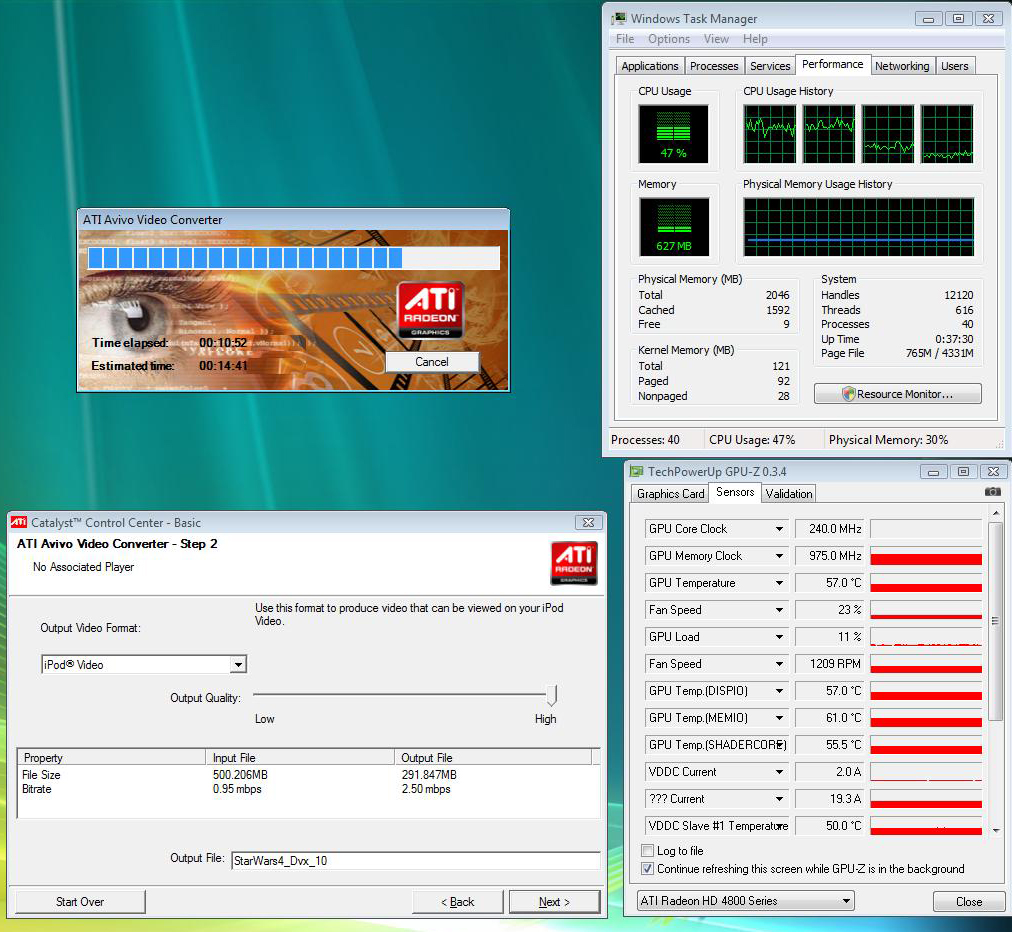ATI Stream: Finally, CUDA Has Competition
Whither Avivo Video Converter?
Interestingly, ATI Avivo Video Converter is now an optional download, not part of the standard Catalyst package. As mentioned, no changes have been made to it as part of this launch. ATI even refers to it as a “reference design for partner developers” and fails to mention the application at the end of its presentation alongside the other Stream-compatible apps. As a true tool for everyday consumers, Converter is unintuitive and surprisingly unsexy. The UI is buried inside of the Catalyst Control Center, accessible through one of two or three basic wizard routines in a menu. You select a source file, change the target folder if you like, and pick from a pull-down menu of non-customizable target profiles, such as iPod or H.264 720p. It’s not difficult, just Spartan and limited.
At a time when there are so few applications to showcase the Stream platform, why would AMD smother its own offspring? Over the last five months, it’s easy to imagine AMD being faced with a choice: do we invest more time and resources to develop Converter, or do we let it stand as-is and work to help partners like CyberLink grow our Stream platform? Pretty obvious answer. Just like AMD is no longer in the chip manufacturing business, it belongs even less in the application writing business. My guess is that AMD will let Converter slip quietly into the night in the months to come. After all, Nvidia doesn’t have a free transcoder, so what’s the pressure for AMD to have one? Early and almost mandatory comparisons between Converter and the far more polished Badaboom couldn’t help but paint a night-and-day picture. There would be no point in AMD trying to belabor such comparisons.
Would I have liked for development to continue on Converter? Sure. Having a fully featured free tool on the ATI Stream side could have been a competitive advantage for AMD at this stage in lieu of a lengthy partner roster. And it’s not like Converter has vanished. You can still download and use it. But it’s no Espresso, nor does AMD appear to want it to be.
Get Tom's Hardware's best news and in-depth reviews, straight to your inbox.
Current page: Whither Avivo Video Converter?
Prev Page Underground Stream: A GPGPU History Next Page The “Balanced Platform”-
radiowars So..... TBH they both work pretty well, I hope that we don't start a whole competition over this.Reply -
falchard Did someone necro an old topic? I think ATI has been talking about ATI Stream for a while. I know atleast a year since FireStream.Reply -
Andraxxus They're good but hopefully they will manage to improve them more. Competition is good for business.Reply -
IzzyCraft Stream is old but not nearly as old and compatible as CUDA I'd get it a year or two more when more capable cards circulate the market and trickle down to the people before i would call it competition.Reply
Well it's good to see more then just 1 app that supports it. -
ThisIsMe Just for the sake of it, and the fact that many pros would like to know the result, it would be nice to see comparisons like this using nVidia's Quadro cards vs. ATI's FirePro cards.Reply -
ohim why use 185.85 since those drivers are a total wreckReply
http://forums.nvidia.com/index.php?showtopic=96665&st=0&start=0
13 pages with ppl having different problems with that driver -
I think the second graph on the "Mixed Messages" page isn't the right graph.Reply
It's the same graph from the following "Heavier Lifting" page instead of a graph for the 298MB VOB file that should be shown? -
Spanky Deluxe Stream and CUDA are likely to go the way of the dodo soon though. OpenCL's where its at. Unfortunately its a tad hard to get programming with it right now since you need to be a registered developer on nVidia's Early Access Program or you have to be a registered developer with Apple's developer program with access to pre-release copies of Snow Leopard.Reply
Virtually no one will bother using CUDA or Steam after OpenCL's out - why limit yourself to one hardware base after all? It'd be like writing Windows software that only ran on AMD processors and not Intel. Developers will not bother writing for both when they can just use one language that can run on both hardware platforms.
